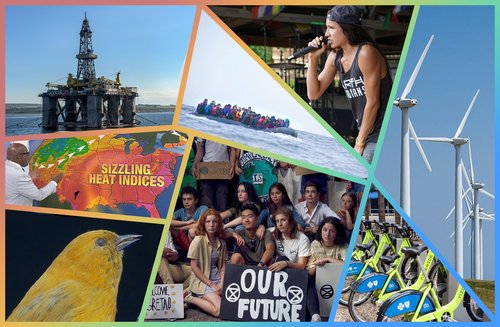
Wildfires, droughts and flooding, health effects on animals, insects and humans — these are just a few of the many ways the climate crisis presents on a local, national, and world stage. SRL would like to know: What does climate change look like in your community?
For this project, your challenge will be to produce a FEATURE STORY about climate change in your community.
If you plan on having a classroom discussion before assigning this challenge, use this Classroom Conversations Guide to help students feel prepared and supported.
Journalism is the activity of gathering, assessing, creating, and presenting news and information.
An account of past or current events. In journalism, stories are presented with a combination of people, facts, and typically includes a beginning, middle and end.
A person or other physical being in a narrative. Stories are made up of different characters who provide information and help shape the narrative with their knowledge, experience and perspective.
Video stories about newsworthy issues and topics, factual information, balanced reporting, research, voice overs, soundbites, b-roll footage, infographics, reporter standup, nats (natural sound bites).
The story of one person, has voiceover (VO), b-roll, pictures, nats (natural sound), interviews of family members or peers of that one person.
Narration and/or voiceover (VO), scene reconstructions, archival footage, nats (natural sound), b-roll, images, research, lengthy interviews, soundbites.
A short extract or clip from a recorded interview, chosen for its relevance to the story, pungency or appropriateness.
Sounds produced in their actual setting. Natural sound, commonly known as NAT sound, puts the viewer in the place the story was told by enhancing the scene(s) with video containing rich audio such as a musician singing at a train station, a storm approaching, or the sound of a tractor plowing the field.
An example of using a little person to tell a big story. For example, you want to tell a story about pollution in your community’s water system. That is a big issue. Your video will use the story of a person (character) to illustrate the effects of bad water quality.
An attempt to grab the reader or viewer’s attention with interesting information that will keep them reading or watching.
The supplemental footage used to visually support your A-ROLL.
Search: broll.
Students recognize the responsibilities and opportunities for positively contributing to their digital communities. (ISTE)
Students leverage technology to take an active role in choosing, achieving and demonstrating competency in their learning goals, informed by the learning sciences. (ISTE)
Whether students are constructing opinions, explanation, or arguments, they will gather information from a variety of sources and evaluate the relevance of that information. (NCSS D3.1.9-12 - D3.2.9-12)
Communicate scientific information that common ancestry and biological evolution are supported by multiple lines of empirical evidence. (NGSS HS-LS4-1)
Students communicate clearly and express themselves creatively for a variety of purposes using the platforms, tools, styles, formats and digital media appropriate to their goals. (ISTE)
Historical understanding requires recognizing this multiplicity of points of view in the past, which makes it important to seek out a range of sources on any historical question rather than simply use those that are easiest to find. It also requires recognizing that perspectives change over time, so that historical understanding requires developing a sense of empathy with people in the past whose perspectives might be very different from those of today. (NCSS D2.His.4.9-12 - D2.His.8.9-12)
Journalism
Climate Change
Stereotypes and Misconceptions
Civics
STEM
Projects
Intermediate
Advanced
Video Conference Software. IE: Zoom or Google Meet
Computers
Camera or Mobile Phone
Internet
Notebook
4-6 Weeks
For this project, your challenge will be to produce a FEATURE STORY about climate change in your community.
Questions to consider:
News Package (3-5 min long):
Video stories about newsworthy issues and topics, factual information, balanced reporting, research, voice overs, soundbites, b-roll footage, infographics, reporter standup, nats (natural sound bites). EXAMPLES:
Short doc or Less "Newsy" Story (4-8 min long):
A short doc or story that shows real events and fact-based information about an issue, person, or place. EXAMPLE:
THINK CRITICALLY
As individuals or in small groups, complete a “Three/Two/One” activity:
FIND YOUR STORY
Use this storytelling roadmap to complete your story. Use it as both a guide and a checklist.
This challenge does not have an active deadline to submit to PBS NewsHour Student Reporting Labs. However, students are encouraged to publish their stories on their school/club/program website or through video/social platforms such as YouTube, Instagram or Twitter and tag Student Reporting Labs. Check with your teacher to find out instructions for class submissions.
FACEBOOK: /STUDENTREPORTINGLABS